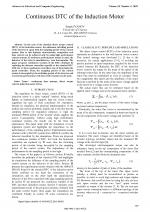| 4/2010 - 24 |
Continuous DTC of the Induction MotorIVANOV, S. |
| Extra paper information in |
| Click to see author's profile in |
| Download PDF |
Author keywords
continuous time systems, direct torque control, induction motor drives
References keywords
control(9), induction(7), torque(5), power(5), motor(5), ivanov(4), electronics(4), direct(4)
Blue keywords are present in both the references section and the paper title.
About this article
Date of Publication: 2010-11-30
Volume 10, Issue 4, Year 2010, On page(s): 149 - 154
ISSN: 1582-7445, e-ISSN: 1844-7600
Digital Object Identifier: 10.4316/AECE.2010.04024
Web of Science Accession Number: 000284782700024
SCOPUS ID: 78649700305
Abstract
In the case of the classical direct torque control (DTC) of the induction motor, the minimum switching period of the inverter is equal with the sampling period of the control system. Due to this intrinsic characteristic, competitive real time control can be achieved only by using high performance control systems. If moderate performances system is used, the behavior of the drive is unsatisfactory, even inacceptable. The paper proposes continuous variants of the DTC, obtained by replacing the discrete controllers specific to the classical DTC with two or three continuous controllers, one of them being the speed controller. Thus, the sampling period of the control system is decoupled by the switching period of the inverter and a moderate performance real time control system can be used. |
| References | | | Cited By |
Web of Science® Times Cited: 7 [View]
View record in Web of Science® [View]
View Related Records® [View]
Updated today
SCOPUS® Times Cited: 9
View record in SCOPUS® [Free preview]
View citations in SCOPUS® [Free preview]
[1] Speed Regulated Continuous DTC Induction Motor Drive in Field Weakening, MATIC, P., VUKOSAVIC, S. N., Advances in Electrical and Computer Engineering, ISSN 1582-7445, Issue 1, Volume 11, 2011.
Digital Object Identifier: 10.4316/AECE.2011.01016 [CrossRef] [Full text]
[2] Analysis of Torque Ripple Reduction in Induction Motor DTC Drive with Multiple Voltage Vectors, ROSIC, M. M., BEBIC, M. Z., Advances in Electrical and Computer Engineering, ISSN 1582-7445, Issue 1, Volume 15, 2015.
Digital Object Identifier: 10.4316/AECE.2015.01015 [CrossRef] [Full text]
[3] Reduction of the starting losses of the wound rotor induction machine, Ivanov, Sergiu, Radulescu, Mihai, 2012 13th International Conference on Optimization of Electrical and Electronic Equipment (OPTIM), ISBN 978-1-4673-1653-8, 2012.
Digital Object Identifier: 10.1109/OPTIM.2012.6231915 [CrossRef]
[4] Direct torque versus predictive control of the induction motor, Ivanov, Sergiu, Ivanov, Virginia, Rasvan, Vladimir, Bobasu, Eugen, Popescu, Dan, 2016 International Conference on Applied and Theoretical Electricity (ICATE), ISBN 978-1-4673-8562-6, 2016.
Digital Object Identifier: 10.1109/ICATE.2016.7754649 [CrossRef]
[5] Comparison of the Current Harmonic Pollution of Asynchronous Motor Drives With Field Oriented Control and Direct Torque Control, Nuca, Iurie, Kostic, Dusan, Nicolae, Petre-Marian, Nicolae, Ileana-Diana, 2023 International Symposium on Electromagnetic Compatibility – EMC Europe, ISBN 979-8-3503-2400-6, 2023.
Digital Object Identifier: 10.1109/EMCEurope57790.2023.10274291 [CrossRef]
Disclaimer: All information displayed above was retrieved by using remote connections to respective databases. For the best user experience, we update all data by using background processes, and use caches in order to reduce the load on the servers we retrieve the information from. As we have no control on the availability of the database servers and sometimes the Internet connectivity may be affected, we do not guarantee the information is correct or complete. For the most accurate data, please always consult the database sites directly. Some external links require authentication or an institutional subscription.
Web of Science® is a registered trademark of Clarivate Analytics, Scopus® is a registered trademark of Elsevier B.V., other product names, company names, brand names, trademarks and logos are the property of their respective owners.
Faculty of Electrical Engineering and Computer Science
Stefan cel Mare University of Suceava, Romania
All rights reserved: Advances in Electrical and Computer Engineering is a registered trademark of the Stefan cel Mare University of Suceava. No part of this publication may be reproduced, stored in a retrieval system, photocopied, recorded or archived, without the written permission from the Editor. When authors submit their papers for publication, they agree that the copyright for their article be transferred to the Faculty of Electrical Engineering and Computer Science, Stefan cel Mare University of Suceava, Romania, if and only if the articles are accepted for publication. The copyright covers the exclusive rights to reproduce and distribute the article, including reprints and translations.
Permission for other use: The copyright owner's consent does not extend to copying for general distribution, for promotion, for creating new works, or for resale. Specific written permission must be obtained from the Editor for such copying. Direct linking to files hosted on this website is strictly prohibited.
Disclaimer: Whilst every effort is made by the publishers and editorial board to see that no inaccurate or misleading data, opinions or statements appear in this journal, they wish to make it clear that all information and opinions formulated in the articles, as well as linguistic accuracy, are the sole responsibility of the author.



